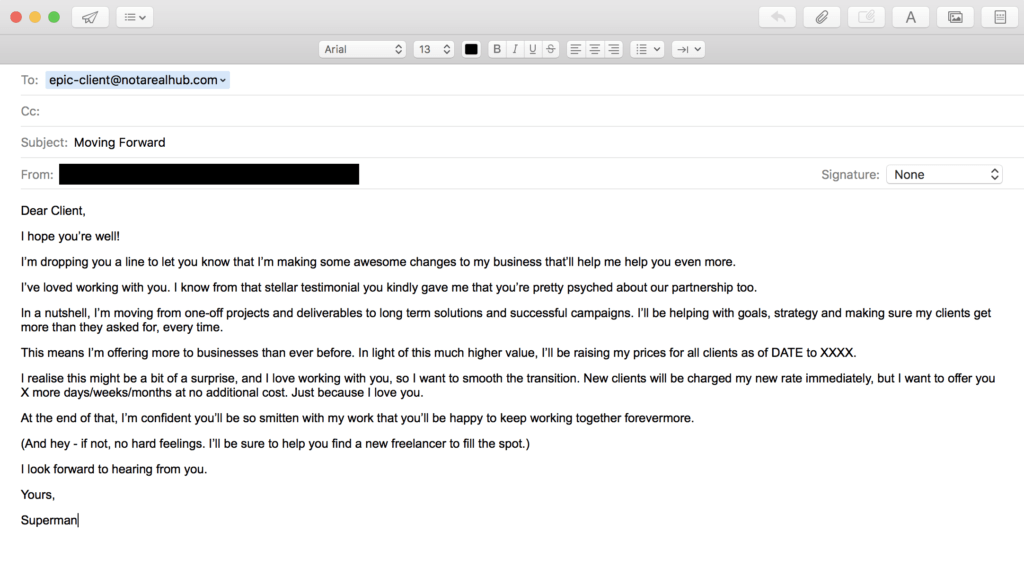Freelancers face challenges all the time.
Successful freelancing is a life that most people can only dream of.
It’s freedom, it’s profit, it’s forging your own badass path.
It’s getting, handling and wrangling your own clients.
(How many of our parents would dream of having their very own clients?)
But as with everything, there’s no such thing as a free ride. Clients make the world go ‘round.
They can also bring it to a grinding halt.
(Don’t worry – this guy is fine. You will be too.)
Every freelancer has their horror story.
A client that seemingly evaporated, taking their fee with them. A client that had a tantrum, said awful things and threatened to tear down your reputation. A client who refused to accept that timezones are a thing and called at 2 a.m. on a daily basis.
Most clients are awesome. They’re great business people and their dreams are just as important as yours.
(And they line your wallets, so … )
But every so often something so unbelievably terrible happens that you become afraid to open your emails.
A client presents an insurmountable challenge. You sit there, looking at the unopened message, hoping that if you stare it down it’ll go away.
Sorry, freelance brothers and sisters. It won’t.
But don’t worry. A lot of disputes, conundrums and all-out catastrophes can be lumped together into five common client challenges — and there’s simple ways to navigate them all.
First, some ground rules:
- Never be rash
- Never be rude
- Never immediately cave in
- Never ghost
- Never give up
Got it?
Now let’s dive into the five common client challenges that might (but hopefully NEVER) crop up in your freelancing business, and how to solve them.
Client Challenge #1: Scope Creep

This little pip nugget crops up a lot on freelance advice websites.
Why’s that?
Because almost everyone has had this to some degree. Mostly small — little extra request here and there, a design project that suddenly needs an extra tweak at the end, a copywriting gig that keeps accruing more and more unforeseen hashtags.
Sometimes the creep is small, and sometimes it’s staggering.
Something like …
Client: Hey, this is great stuff!
Freelancer: Glad you think so! I think that’s a wrap. Can you please sign off—
Client: Can you just add a quick social media calendar to this digital marketing project?
Freelancer: Er … a whole calendar?
Client: Yeah! I know we said we didn’t want one originally, but we thought about what you said and we totally need one now. It’s not much work.
Freelancer: Actually—
Client: Awesome. Can you get that done by tomorrow? It’ll match up great with our new Facebook page.
Freelancer: What Facebook page?
Client: The one you’re gonna launch for us. It’s all part of the “digital” thing, right?
Freelancer: But that’s not part of the agreed project scope.
Client: It’s only a little addition. You don’t mind, right?
FYI: You do mind. Dramatically so.
Obviously, this example is a horror show. But scope creep eats into your precious time, taking away opportunity to work on other client gigs and make money. And it’s just plain not cool. The client might not even realize they’re essentially asking you to work for free — and you might feel like a Scrooge saying no.
But you’ve got to say no, because working for free is the worst. Particularly when you didn’t agree on it in the first place.
And doing it once sets a standard for extra tidbit requests from that client.
Let the scope creep once, and it’ll probably never stop creeping.
The Solution: Contracts
You should have a contract for all your freelancing work, to establish ground rules and enforce good behaviour from all parties.
To begin with, lay down exactly what the project entails. Be as detailed as physically possible. You’re not being neurotic, you’re being perfectly reasonable and protecting your value — and sanity.
For example:
The writer will complete X number of articles at X words each, to be delivered on the Xth of every month by XX a.m.
If you lay down in writing exactly what your client can expect, it’ll be easier to politely call out scope creep as being literally out of project scope.
It’s also great idea to add a clause in covering scope creep.
Obviously you don’t call it “the scope creep clause.” That’s going to ruffle a few feathers.
Instead, list it as “additional work.” Lay down how work outside the original agreement will be received, priced and undertaken.
For example, extra ad hoc work could be priced higher than project work. So long as that’s made abundantly clear in the contract, there’s no reason for a client to baulk.
There’s nothing wrong with going the extra mile for a client.
In fact, it’s pretty dang awesome. If they reach out respectfully to ask you to do extra and it’s a reasonable amount of work, consider it.
But set solid boundaries, understand your value and use detailed agreements to bypass any possibility of scope creep.
Client Challenge #2: Raising Your Rates
Say you’ve had this client a long time. They’re adorable and you want to keep them.
But your value is skyrocketing and you just can’t take working for less than you’re worth anymore.
That means contacting clients and essentially asking them to pay you more.
It seems simple. People negotiate raises all the time in office jobs.
So why is it so scary to do as a freelancer?
Because raising your rates with no strategic approach is a quick way to lose the client.
Remember, what you’re essentially saying is …
Freelancer: I’m more experienced and valuable, so I’m going to double my rates starting tomorrow.
Client: lolwut?
You know you’re worth more – but does the client? As far as they can see, you’re asking for more money for the same service. They might expect your rates to go up a little every year like most jobs do, but a noticeable shift in rates is going to get some raised eyebrows.
They might even start scouting for someone else to take your place.
The Solution #1: Focus On How To Present Your Offer
First off, you’ve got to be indispensable. If you’re not already worth every penny they’re paying you and more, you’ve got little chance of successfully negotiating a higher rate.
But you’re awesome, so that’s not a problem.
Don’t bother trying to convince a client that you’re still a “steal” of a price. First, you shouldn’t be the cheapest option, and second, you’re raising your rates. Ergo, you’re not going to win a bidding war.
Instead, restructure your offer.
Make no apologies for raising your rates, but figure out how you can offer another level of value without working much harder, and re-present your offering accordingly.
For example, you might be a copywriter working on some kickass blog posts for your client. You want to raise your rates. Figuring out writing rates is already such a minefield that you’re going to need to position yourself as beyond irresistible to get any traction.
You might offer broader digital marketing and strategic services. Something that appeals to long-term goals, not just monthly content.
For example, your email might go thusly …

Personable, no big deal, reasonable terms.
Even if the client isn’t up for paying you what you’re worth, at least there’s nothing here to spark hard feelings or an argument. And hey, if they’re not willing to pay, then you’ve probably not got much of a future together anyway.
The Solution #2: Go Slow(ish)
Ripping off the Band-Aid is what everyone recommends. But we all know easing it off little by little makes the pain a little less.
If you’re planning on raising your rates sky high, consider going for the softly-softly approach.
Instead of telling your client you’re going to charge them thrice what you offered originally (and open the floor for tantrums and panicking) raise your rates little by little over a longer period of time.
This depends on your situation, but if you desperately want to keep the client and can afford to ease the transition, consider raising your prices regularly but at smaller increments. You’ll be getting paid more, and the client won’t worry.
Raising rates is totally normal in business.
Think of utility bills. It just needs to be handled professionally and you’re good to go.
Client Challenge #3: Refunds
It’s an email no one wants.
It can make you feel physically sick or fill you with the impulse to fling your computer through the nearest window.
Ever had a client, for whatever reason, demand their fee back in full?
This isn’t about when a client asks for money back because the freelancer ruined everything. You’re not that kind of freelancer.
(FYI, if it was totally your fault and you didn’t deliver, you should probably consider at least a partial refund.)
This is for when refunds come out of the blue. A client changes their mind or scams you.
They might ask for a refund as a knee-jerk reaction to extra fees for additional work, or just be an all-around bad egg.
If you’ve already delivered work to a good standard, even if they decide they don’t want it anymore, you don’t owe them a cent.
Legally, you must be paid for work you have completed, and are within your rights to add interest to outstanding payments.
You might be sensing a theme here, but while you can’t stop clients freaking out and being unreasonable, you can circumvent refund grey areas with …
The Solution: Contracts and Communication
The contract strikes again!
(But seriously! They’re important.)
Contracts act as guidelines for freelance gigs, encouragement for clients in disputes, and at worst, solid grounding in court.
Hopefully you’ll never have to go to court to get what you’re owed. That would super suck.
Set out a Termination Clause or stick your refund policy in your Terms and Conditions. State specific scenarios and your processes for handling them. Lay out what happens if the client wants to cancel, and what happens if you want to cancel.
It’s worth doing two separate paragraphs for each of you.
Instead of offering refunds, consider offering additional revisions for a fee.
Just ensure that these terms are public and clear in your contract. Leave no room for error.
Most times, payment disputes can be settled by pointing out these clauses in your contract. Sure, your client might flip you off and never offer you work again, but at least you’re not out of pocket.
There are plenty of great clients out there to fill the void.
Client Challenge #4: MIA Clients
It’s tough to decide which is worse: refund demands or clients that evaporate / melt / beam away / disappear off the face of the earth with no warning.
Most people call it “ghosting.”
And it stinks.
You’re particularly screwed if you get paid upon completion.
If a client is prone to disappearing in a puff of smoke for months on end, you’re probably well rid of them. But if they’ve beamed up without paying you … that’s a different story.
You need to have a process in place for handling this kind of problem. It sucks, but it’ll save you headaches and heartache down the line.
Don’t feel guilty. The more brutal you are with laying down ground rules, the easier it will be to fix problems like this — the easy way or the hard way.
The Solution: Plan Ahead
First of all, don’t jump to conclusions!
The client might just be buried under a pile of paperwork, struggling to get out. Maybe something happened in their personal lives.
Obviously going MIA is bad. But you just never know what’s really up.
Send periodic, polite reminders and follow ups. Try over different platforms if possible. If emails are falling through the cracks, try Skype messaging or Slack.
But once a certain amount of time has passed, you’re going to have to sort out the situation. Dealing with clients that have vanished into the ether is made much easier by having a process for closing idle contracts and making sure your cash flow is protected.
Include a clause in the contract that outlines what happens if your client doesn’t get in touch for a certain amount of time. For example, if they go radio silent over 14 days, the contract is considered void and no refunds will be offered.
Brutal? Maybe a little.
But 100% fair.
As a freelancer and badass owner of your own business, you write your own business policies. They’re just as solid and serious as the policies of any big business.
You wouldn’t see a big brand compromising on their policies because a customer flaked or screwed with their product. Why should you?
Client Challenge #5: Firing Clients
You’ve reached the end of your tether.
Maybe the problem is that …
- The client’s brand and/or personality isn’t a fit
- Your schedule is full and they’re your lowest-paying client
- They’re flaky on invoices and communication
- They’re scope creep kings
- Your skills have outgrown the work they’re offering
Maybe the client has tried to do all of the stupid things listed in this blog with no excuse or reason.
(Bad luck on that one!)
It’s time to do something that might go completely against your freelance grain and give a potential moneymaker the sack.
This is particularly tricky if you’ve known them for a long time. Or if they’re a big boy.
But if it’s got to be done, it’s got be done right. You need to gracefully and politely sever ties, tell them what’s going to happen next, and try to not burn bridges.
That’s the hard part.
Think of it from the client’s perspective.
Even if they’re the biggest tool in the box, you’re still breaking up with them. You know how much it hurts to be rejected?
Yeah, a lot.
You’ve got to protect your reputation above all else, and kicking a client to the curb the wrong way will come back to bite you eventually.
Sending the breakup email might make you want to vomit. But if you write it right, you’ll be fine.
These are three email scripts you can merrily steal, edit and use to your heart’s content.
Just don’t …
- Get personal
- Be too emotive
- Send an essay
- Be unreasonable
Got it? Go forth and fire your problem clients (with respect, professionalism and badassery).
Script #1: Business Decision
Even if it’s not strictly true, soften the blow by citing long-term goals as the reason for splitting up. Then you’re not placing blame and offending anyone.
“Hi XXXX,
I hope you’re doing well. Thanks so much for the opportunity to work on this project with you.
[Put in at least one positive.]
I’ve undertaken strategic analysis of my long-term goals, and have decided to shift my focus to [something else.]
I therefore regret to say that, moving forward, I will no longer be able to work on your projects from [closing date]. Please consider this message official notice of cancellation of our agreement / project.
I appreciate this may be inconvenient for you, and I’d be happy to recommend [other freelancer] to fill your requirements.
Thank you for your understanding. It’s been a pleasure working with you and I wish you all the best. I’ve attached a document detailing what you can expect from me between now and [closing date].
Yours,
NAME”
Script #2: Take The Blame
If it’s been a tumultuous relationship and you’re desperate to cut ties without pointing the finger, you could exercise a little grace and pretend it’s your fault — in a controlled, not-too-bad sort of way.
“Hi XXXX,
I hope you’re doing well. Thanks so much for the opportunity to work on this project with you.
[Put in at least one positive.]
I regret to inform you that, due to personal circumstance, I will no longer be able to work on your projects from [closing date]. Please consider this message official notice of cancellation of our agreement / project.
[Elaborate if you want. You don’t have to. And don’t get too personal.]
I appreciate this may be inconvenient for you, and I’d be happy to recommend [other freelancer] to fill your requirements.
Thank you for your understanding. It’s been a pleasure working with you and I wish you all the best. I’ve attached a document detailing what you can expect from me between now and [closing date].
Yours,
NAME”
Script #3: Be (Mostly) Honest
If they’ve just been that much of a jerk and you want to make doubly sure they never, ever knock on your door again, you could be a little more blunt.
That’s not to say you need to tell them exactly what you think of them. This isn’t an episode of Suits.
This is the trickiest one because it strays into the getting personal danger zone. Only use it when the client is just that awful. Be prepared for some feedback, but stick to your guns. Once you’ve sent a breakup email, it won’t be forgotten.
“Hi XXXX,
I hope you’re doing well. Thanks so much for the opportunity to work on this project with you.
I’ve noticed recently that we’ve had some issues with our collaboration.
[Add detail but be careful to not be childish — even if it’s all their fault.]
I therefore regret to inform you that I think we’re no longer a good fit. As of [closing date], I will no longer be able to work on your projects. Please consider this message official notice of cancellation of our agreement / project.
I appreciate this may be inconvenient for you, and I’d be happy to recommend [other freelancer] to fill your requirements.
[If they’re so awful you wouldn’t even send them to your competition, leave that paragraph out.]
Thank you for your understanding. I’ve attached a document detailing what you can expect from me between now and [closing date].
Yours,
NAME”
How To Skip Everything
It’s easy to say in hindsight, but all of these problems can be skipped once you’ve got a nose and a process for screening bad egg clients.
If a client …
- Says it’ll be “easy” and “quick”
- Immediately asks for rates and then questions them
- Immediately asks for discounts
- Sets unrealistic timeframes
- Asks for free spec work
- Doesn’t respect your time
… or just sets your gut feeling alarm off, then back away before the project has begun. Taking on a client that makes you want to burn things is (almost) never worth it.
Screen your clients and set your standards.
And even if one slips through the net, have an iron-clad contract in place to cover your freelancing butt.
Always be respectful and professional — but place your business needs first. If you have to irrevocably cut ties, complete due diligence and any wrap-up work required on your part.
Remember, these aren’t negotiations. They’re notifications. Stand your ground and move on.
Don’t forget to learn from every mistake.
Remember the red flags to watch out for, and treat every snafu as a learning experience.
It’s better than bawling into a glass of wine.
Build Your Freelance Dream Business
Interested in learning more about building your dream freelance business filled with your dream clients?





